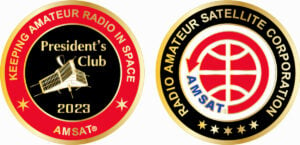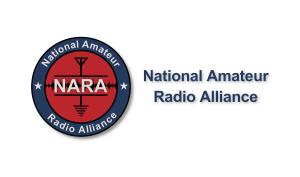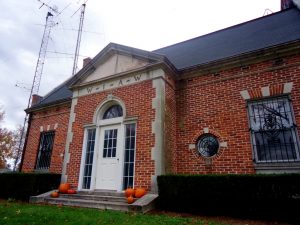In this edition:
* AMSAT Board Appoints Officers, Hears Reports
* AMSAT Board Discusses Policies and Procedures
* AMSAT Symposium Takes Place in Dallas
* ESTCube-2 Fails to Deploy After Launch
* Scientists Confirm Ancient Solar Storm
* Changes to AMSAT-NA TLE Distribution for Oct. 19
* EVA Event Upcoming on ISS
* ARISS News
* Upcoming Satellite Operations
* Hamfests, Conventions, Maker Faires, and Other Events
* Satellite Shorts From All Over
The AMSAT News Service bulletins are a free, weekly news and information service of AMSAT, the Radio Amateur Satellite Corporation. ANS publishes news related to Amateur Radio in Space including reports on the activities of a worldwide group of Amateur Radio operators who share an active interest in designing, building, launching and communicating through analog and digital Amateur Radio satellites.
The news feed on http://www.amsat.org publishes news of Amateur Radio in Space as soon as our volunteers can post it.
Please send any amateur satellite news or reports to: ans-editor [at] amsat.org
You can sign up for free e-mail delivery of the AMSAT News Service Bulletins via the ANS List; to join this list see: https://mailman.amsat.org/postorius/lists/ans.amsat.org/
ANS-295 AMSAT News Service Weekly Bulletins
To: All RADIO AMATEURS
From: Radio Amateur Satellite Corporation
712 H Street NE, Suite 1653
Washington, DC 20002
DATE 2023 OCT 22
AMSAT Board Appoints Officers, Hears Reports
The AMSAT Board of Directors met on Thursday, Oct. 19 in Dallas, Texas in advance of the annual meeting and Symposium.
Since Board members whose terms were expiring were all re-elected, the Board was as previously constituted. Frank Karnauskas was welcomed as the new Alternate Board member.
+ All officers were re-appointed by acclamation:
President — Robert Bankston, KE4AL, Dothan, AL
Executive Vice President — Paul Stoetzer, N8HM, Washington, DC
Vice President – Engineering — Jerry Buxton, N0JY, Granbury, TX
Vice President – Operations — Drew Glasbrenner, KO4MA, Brooksville, FL
Vice President – Educational Relations — Alan Johnston, KU2Y, Philadelphia, PA
Vice President – Development — Frank Karnauskas, N1UW, Tucson, AZ
Treasurer — Steve Belter, N9IP, West Lafayette, IN
Secretary — Jeff Davis, KE9V, Yorktown, IN
+ President Robert Bankston gave his President’s Report. His focus was on improving transparency and accountability between AMSAT leadership and membership. This would include better reporting of finances, better standards for publishing our accomplishments, more attention to Member Services for member satisfaction, and redesign of the AMSAT website.
+ Treasurer Steve Belter was not in attendance, but the Treasurer’s Report was given on his behalf. The financial status of the organization is healthy.
+ Alan Johnston, Vice President – Educational Relations, reported that the CubeSat Simulators are getting good use in the amateur community, as well as in universities and high schools. The Simulator circuit boards have been selling well, and the fully built loaners are circulating constantly. An upgraded Simulator board, v.2, is in beta, and testers will be recruited from among builders of version 1. A new v.2 kit should become available next year.
+ The engineering report by Jerry Buxton, Vice President – Engineering, and Jonathan Brandenburg, KF5IDY, Assistant Vice President – Engineering. The engineering team now consists of more than 35 volunteers, each working 4 to 5 hours per week, on various projects for Fox-Plus, GOLF, ASCENT, and other related efforts. Recruiting of engineering volunteers is ongoing.
Engineering challenges include supply chain problems and inflationary pressures. As technology advances quickly, some components become unavailable in the space between planning and construction. Export Administration Regulations (EAR) make international cooperation difficult.
The GOLF (Greater Orbit, Larger Footprint) program was approved in 2017 as an incremental development path for return to High Earth Orbit (HEO). Applications for the first two satellites in this program, GOLF-TEE and GOLF-1, have both been accepted by NASA. The satellites are under construction, and the first will be delivered to NASA in late 2025, but there is no time frame for launch at this time.
ASCENT (Advanced Satellite Communication and Exploration of New Technology) allows a “sandbox” for future satellite systems to be explored for eventual flight. Some of these projects are being incorporated into GOLF, including the deployable solar panels and the 3U cubesat structure.
Fox-Plus, a 1U cubesat, is currently under construction utilizing the Linear Transponder Module similar to those that have been supplied to partners such as HuskySat and MESAT-1. The first Fox-Plus satellite will be completed no earlier than late 2024, with no time frame for launch at this time.
+ Vice President – Operations, Drew Glasbrenner, gave a rundown on satellites in orbit. We have a number of old satellites that keep chugging along, and the Operations team manages these resources as possible.
+ Vice President – Development, Frank Karnauskas, reported on plans to celebrate the 50th anniversary of AO-07 and the publicity surrounding it. There was also discussion of the AMSAT News Service bulletins and how they are distributed.
+ The IT report focused on the availability of @amsat.org email accounts. Costs of maintaining this service have increased immensely, and there have been many problems with spam filters crushing mail sent through this service.
+ Board Member Bruce Paige, KK5DO, reported on AMSAT Field Day and the awards programs. The AMSAT Store, reached through the amsat.org website, continues to do a brisk business with the SatPC32 tracking program being the best seller.
+ Export Control and Economic Sanctions Compliance Training was the last item on the agenda. President Bankston briefed the Board on current legal requirements.
[ANS thanks AMSAT for the above information]
+=+=+=+=+=+=+=+=+=+=+=+=+=+=+=+=+=+=+=+=+=+=+=+=+=+=+=+=+=+=+=+=+=
The 2023 AMSAT President’s Club coins are here now!
To commemorate the 40th anniversary of its launch
on June 16, 1983, this year’s coin features
an image of AMSAT-OSCAR 10.

Join the AMSAT President’s Club today and help
Keep Amateur Radio in Space!
https://www.amsat.org/join-the-amsat-presidents-club/
+=+=+=+=+=+=+=+=+=+=+=+=+=+=+=+=+=+=+=+=+=+=+=+=+=+=+=+=+=+=+=+=+=
AMSAT Board Discusses Policies and Procedures
President Robert Bankston reconvened the Board of Directors on Friday morning, Oct. 20. Bankston opened with a discussion of AMSAT’s policies and procedures, specifically the financial policies and procedures.
Discussion ensued regarding communicating information regarding Engineering projects and a public release of schedules. In some cases, legal agreements preclude release of specific launch information.
Discussion also continued regarding budgeting procedures for Engineering projects. Bankston compiled a list of further items for new business to discuss by the end of the meeting. Further new business discussion followed.
Paul Stoetzer raised the issue of a document repository to manage corporate documents for improving management and communication. It was broadly agreed that AMSAT would seek a solution in concert with the IT team.
Drew Glasbrenner was recognized to discuss a potential updated satellite tracking software.
A concern was raised that more senior AMSAT leadership should attend various conferences and events. It was agreed that there would be an increase in the amount budgeted for attendance at conferences in the 2024 Budget.
There was discussion of allocating funds for services would be contracted for user services, since AMSAT no longer has any employees.
A discussion also ensued on the AMSAT IP Policy. It was agreed that ideas for updating it would be developed and discussed in January.
Alternate Director Frank Karnauskas was recognized to discuss the need to define positions before filling them with volunteers. Some feel that positions need to be flexible in order to fit the willingness of volunteers.
Jerry Buxton opened discussion of ITU/FCC satellite authorization. He suggested obtaining external support to handle applications for satellite authorization. Drew Glasbrenner, as the AMSAT licensee, concurred. It was broadly agreed that it would be a benefit.
As the 50th anniversary of AO-7 draws near, plans are in the works for celebrating the anniversary.
Also discussed were potential locations for the 2024 Symposium. It was broadly agreed that Florida would be the location.
President Bankston mentioned his desire for re-engagement with our sister AMSATs around the world on satellite programs. The Board broadly agreed that the President should reach out to international AMSAT leadership and begin discussions.
The need was discussed for an updating of the Getting Started Guide and the need for a new editor.
President Bankston adjourned the meeting so that all could move on to attending the 41st AMSAT Symposium.
[ANS thanks Paul Stoetzer, Acting Secretary, for the above information]
AMSAT Symposium Takes Place in Dallas
The 41st AMSAT Space Symposium & Annual General Meeting was held October 20-21 in Dallas, Texas. Nearly 60 participants were in attendance. The Symposium sessions will be available for viewing on AMSAT’s YouTube channel at https://www.youtube.com/@AMSATNA/
Friday, October 20
+ Welcome from Robert Bankston, KE4AL, AMSAT President
+ A Survey of Small Satellite Propulsion Systems by Jonathan Brandenburg, KF5IDY, AMSAT Assistant VP Engineering
+ AMSAT Engineering Update from Jerry Buxton, N0JY, AMSAT VP Engineering; Jonathan Brandenburg, KF5IDY, AMSAT Assistant VP Engineering; sZach Metzinger, N0ZGO, AMSAT Board of Directors
+ PACSAT Update and Demonstration by Bill Reed, NX5R, PACSAT Project Manager, et al
Saturday, October 21
+ Welcome from Robert Bankston, KE4AL, AMSAT President
+ CubeSatSim Update and Demonstration by Alan Johnston, KU2Y, AMSAT VP Educational Resources
+ ThinSat Project for High Schools by Nick Pugh, K5QXY, and Bob Twiggs, KE6QMD
+ AMSAT Youth Initiative by Frank Karnauskas, N1UW, AMSAT VP Development
+ Amateur Radio Spectrum Use in the Lunar Environment by Frank Bauer, KA3HDO, ARISS-NA Executive Director
+ Amateur Satellite Secondary Payloads by Drew Glasbrenner, AMSAT Board of Directors/VP Operations
+ AMSAT-HB Update from Michael Lipp, HB9WDF, President, AMSAT-HB
+ ARISS Update from Dave Taylor, W8AAS, AMSAT U.S. Delegate to ARISS International
+ 40th Anniversary of Hams in Space & 2024 Anniversary Event by Frank Bauer, KA3HDO, ARISS-NA Executive Director
+ Planned Non-AMSAT Amateur Satellites by Paul Stoetzer, N8HM, AMSAT Executive Vice President
+ Space Qualified Antennas by Kent Britain, WA5VJB
The session was followed by the AMSAT Annual General Meeting & Awards Ceremony, and in the evening, by the AMSAT Symposium Banquet.
[ANS thanks AMSAT for the above information]
+=+=+=+=+=+=+=+=+=+=+=+=+=+=+=+=+=+=+=+=+=+=+=+=+=+=+=+=+=+=+=+=+
Need new satellite antennas? Purchase Arrows, Alaskan Arrows,
and M2 LEO-Packs from the AMSAT Store. When you purchase through
AMSAT, a portion of the proceeds goes towards
Keeping Amateur Radio in Space.
https://amsat.org/product-category/hardware/
+=+=+=+=+=+=+=+=+=+=+=+=+=+=+=+=+=+=+=+=+=+=+=+=+=+=+=+=+=+=+=+=+
ESTCube-2 Fails to Deploy After Launch
A pair of payloads that were among 12 carried to orbit aboard the Arianespace-managed Vega VV23 flight failed to be deployed and likely burned up in the atmosphere still attached to the rocket’s upper stage.
The Vega VV23 flight was launched on October 9 at 01:36 UTC from the Guiana Space Centre in French Guiana. The rocket carried the THEOS-2 and FORMOSAT-7R/TRITON satellites as its primary payloads and ten smaller satellites as secondary payloads.
Following a successful launch, Arianespace published a press release confirming that the two primary payloads and eight of the ten secondary payloads had been deployed. However, the launch services provider added that “the separation of the last 2 cubesats is still to be confirmed.”
The launch utilized the Small Spacecraft Mission Service (SSMS) dispenser, which was designed by SAB Aerospace for Avio and is operated by Arianespace with the support of SAB Launch Services.
In an email sent by Arianespace to the affected teams that European Spaceflight has seen, the launch services provider explained that the ESTCube-2 and ANSER-Leader cubesats likely failed to separate from their respective deployers.
“Following the VEGA VV23 launch last Sunday, ARIANESPACE has now the strong suspicion that your satellites ESTCube-2 and ANSER-Leader were unfortunately not separated from their respective deployers,” said the email.
ESTcube-2, a 3U cubesat, was built by the Estonian Student Satellite Foundation and was supposed to carry a 9600bps digipeater similar to the former FalconSat-3, as well as several other amateur-related experiments.
[ANS thanks European Spaceflight for the above information]
Scientists Confirm Ancient Solar Storm
The largest known solar storm struck Earth more than 14,000 years ago, according to a new study of the growth rings in ancient trees. A similar storm striking Earth at present would likely knock out radio communications and satellites while causing widespread blackouts.
Carbon-14 (C14), the rarest carbon isotope on the planet, is primarily formed by cosmic rays emitted by the Sun through solar flares and coronal mass ejections interacting with the Earth’s atmosphere. The radioactive carbon isotope can eventually be absorbed by living organisms — like trees, plants and animals — throughout their lifetimes. The amount of C14 in certain organisms can reflect how abundant the isotope was in the atmosphere and, by extension, the amount of solar activity present at a given time.
A team of scientists discovered evidence of the storm by measuring the levels of C14 in rings of ancient pine trees that lived in the French Alps more than 14,000 years ago.
The researchers hypothesized that the abrupt spike was likely from a massive solar storm that was probably two times larger than all other major storms on record.
To verify their hypothesis, the researchers turned to ice cores, or cylinders of ice drilled from ice sheets and glaciers. They discovered that the C14 spike in the trees corresponded with an unusual concentration of beryllium-10 from between 14,301 and 14,292 years ago found in a Greenland ice core.
Tim Heaton, a professor of applied statistics at the University of Leeds and a co-author of the new study in the journal, Philosophical Transactions of the Royal Society A, noted that, “Extreme solar storms could have huge impacts on Earth. They would also create severe radiation risks to astronauts.”
[ANS thanks Axios Space for the above information]
+=+=+=+=+=+=+=+=+=+=+=+=+=+=+=+=+=+=+=+=+=+=+=+=+=+=+=+=+=+=+=+=+
Want to fly the colors on your own grid expedition?
Get your AMSAT car flag and other neat stuff
from our Zazzle store!
25% of the purchase price of each product goes
towards Keeping Amateur Radio in Space
https://www.zazzle.com/amsat_gear
+=+=+=+=+=+=+=+=+=+=+=+=+=+=+=+=+=+=+=+=+=+=+=+=+=+=+=+=+=+=+=+=+
Changes to AMSAT-NA TLE Distribution for Oct. 19
Two Line Elements or TLEs, often referred to as Keplerian elements or keps in the amateur community, are the inputs to the SGP4 standard mathematical model of spacecraft orbits used by most amateur tracking programs. Weekly updates are completely adequate for most amateur satellites. Elements in the TLE bulletin files are updated daily. TLE bulletin files are updated to add or remove satellites as necessary Thursday evenings around 2300 UTC, or more frequently if new high interest satellites are launched. More information may be found at https://www.amsat.org/keplerian-elements-resources/
The following satellites have been removed from this week’s AMSAT-NA TLE distribution:
Robusta 1B NORAD Cat ID 42792 Decayed from orbit on or about 16 October 2023
LO-87 LUSEX NORAD Cat ID 41557 Decayed from orbit on or about 19 October 2023
[ANS thanks AMSAT Orbital Elements page for the above information]
EVA Event Upcoming on ISS
Two NASA astronauts aboard the International Space Station will conduct a spacewalk Monday, Oct. 30, to complete maintenance activities at the orbital complex.
Live coverage of the spacewalk begins at 6:30 a.m. EDT on NASA Television, the NASA app<https://www.nasa.gov/apps/>, and the agency’s website<https://www.nasa.gov/nasatv/>. The spacewalk is scheduled to begin about 8:05 a.m., and last about six-and-a-half hours.
NASA astronauts Jasmin Moghbeli, KI5WSL, and Loral O’Hara, KI5TOM, will exit the station’s Quest airlock to remove an electronics box called the Radio Frequency Group from a communications antenna on station. They also will replace one of 12 trundle bearing assemblies on a solar alpha rotary joint. The bearings enable the station’s solar arrays to rotate properly to track the Sun as the station orbits the Earth. When looking at the space station, the antenna is on the starboard (right side) truss, and the rotary joint is on the port, or left side.
U.S. spacewalk 89 will be the first for both Moghbeli and O’Hara. Moghbeli will serve as extravehicular activity crew member 1 and will wear a suit with red stripes. O’Hara will serve as extravehicular crew member 2 and will wear an unmarked suit.
Station managers continue planning for another spacewalk with O’Hara, as well as ESA (European Space Agency) astronaut Andreas Mogensen, to collect samples for analysis to see whether microorganisms may exist on the exterior of the orbital complex. That spacewalk, which now is U.S. spacewalk 90, has been postponed to no earlier than December.
[As always, if there is an EVA, a docking, or an undocking; the ARISS radios are turned off as part of the safety protocol.]
[ANS thanks NASA for the above information]
ARISS NEWS
Amateurs and others around the world may listen in on contacts between amateurs operating in schools and allowing students to interact with astronauts and cosmonauts aboard the International Space Station. The downlink frequency on which to listen is 145.800 MHz worldwide.
RECENTLY COMPLETED:
Valley Stream South High School, Valley Stream, NY, telebridge via IK1SLD
The ISS callsign was OR4ISS
The crewmember was Andreas Mogensen, KG5GCZ
The ARISS mentor was AB1OC
Contact was successful: Tue 2023-10-17 12:25:03 UTC 38 deg
Congratulations to the Valley Stream South High School students, Andreas, and mentor AB1OC!
Watch the video at https://youtube.com/live/g74NbsTEvVw?feature=share
St Peter in Thanet CE Junior School, Broadstairs, Kent, United Kingdom, direct via GB4SPT
The ISS callsign was NA1SS
The crewmember was Loral O’Hara, KI5TOM
The ARISS mentor was MØXTD
Contact was successful: Wed 2023-10-18 09:57:49 UTC 89 deg
Congratulations to the St Peter in Thanet CE Junior School students, Loral, and mentor MØXTD!
UPCOMING:
A. L. Burruss Elementary School, Marietta, GA, direct via K4RGK
The ISS callsign is presently scheduled to be NA1SS
The scheduled crewmember is Jasmin Moghbeli, KI5WSL
The ARISS mentor is K4RGK
Contact is go for: Tue 2023-10-24 16:14:50 UTC 74 deg
Watch for Livestream at http://www.youtube.com/channel/UCuI4sKDBpERtEFs9bFrRMFA/live
The crossband repeater continues to be active (145.990 MHz up {PL 67} & 437.800 MHz down). If any crewmember is so inclined, all they have to do is pick up the microphone, raise the volume up, and talk on the crossband repeater. So give a listen, you just never know.
The packet system is Temporarily stowed. (145.825 MHz up & down).
As always, if there is an EVA, a docking, or an undocking; the ARISS radios are turned off as part of the safety protocol.
Note, all times are approximate. It is recommended that you do your own orbital prediction or start listening about 10 minutes before the listed time.
The latest information on the operation mode can be found at https://www.ariss.org/current-status-of-iss-stations.html
The latest list of frequencies in use can be found at https://www.ariss.org/contact-the-iss.html
[ANS thanks Charlie Sufana, AJ9N, one of the ARISS operation team mentors for the above information]
Upcoming Satellite Operations
Ray, KN2K, will be in FM17 the morning of Wednesday, 25th October and will be QRV for a number of morning passes. Check hams.at for details.
Please submit any additions or corrections to k5zm (at) comcast (dot) net.
[ANS thanks Ian Parsons, K5ZM, AMSAT rover page manager, for the above information]
Hamfests, Conventions, Maker Faires, and Other Events
AMSAT Ambassadors provide presentations, demonstrate communicating through amateur satellites, and host information tables at club meetings, hamfests, conventions, maker faires, and other events.
+ 41st AMSAT Space Symposium & Annual General Meeting
October 20-21, 2023
Sheraton DFW Airport Hotel
4440 W John Carpenter Fwy, Irving, TX 75063
AMSAT Ambassador Clint Bradford, K6LCS, says,
“Think a 75-minute presentation on “working the easy satellites” would be appropriate for your club or event? Let me know by emailing me at k6lcsclint (at) gmail (dot) com or calling me at 909-999-SATS (7287)!”
Clint has NEVER given the exact same show twice: EACH of the 150+ presentations so far has been customized/tailored to their audiences.
[ANS thanks the AMSAT Events page for the above information]
Satellite Shorts From All Over
+ ARRL has released TQSL v.2.7.1 for Windows, Mac and Linux as of Oct. 17, 2023. Users of Logbook of the World should update to the latest version at their earliest opportunity. (ANS thanks ARRL/LoTW for the above information)
+ The presentations from the 50th Anniversary AMSAT-DL Satellite Meeting on September 16, 2023 in Bochum are available on the AMSAT-DL YouTube channel: https://www.youtube.com/@amsatdl/videos. Though many are in German, some presentations are in English. (ANS thanks AMSAT-DL for the above information)
+ The ISS experienced another coolant leak, this time on a radiator circuit that is part of the Russian Nauka module—the crew and station are safe, and there is a spacewalk planned later this month to investigate the root cause. (ANS thanks The Orbital Index for the above information)
+ Researchers at Purdue University’s College of Science found metals high in Earth’s stratosphere. Those metals are altering the chemistry in our planet’s atmosphere in ways we don’t fully understand, and may be causing damage to the earth’s protective ozone layer. The team concluded that the aerosols of over 20 chemical elements, including lithium, aluminum, copper, and lead, come from vapour boiling off of the surfaces of spent boosters and other space debris as it re-enters the atmosphere and burns up. (ANS thanks Universe Today for the above information)
+ SpaceX filed for a 29,988 satellite W-band network—likely around 71-86 GHz which offers higher data rates but suffers more atmospheric attenuation—this filing is presumably part of SpaceX’s original 42,000 satellite proposed constellation and would quadruple the number of active satellites that humanity has in orbit. (ANS thanks The Orbital Index for the above information)
Join AMSAT today at https://launch.amsat.org/
In addition to regular membership, AMSAT offers membership to:
* Societies (a recognized group, clubs or organization).
* Primary and secondary school students are eligible for membership at one-half the standard yearly rate.
* Post-secondary school students enrolled in at least half time status shall be eligible for the student rate for a maximum of 6 post-secondary years in this status.
* Memberships are available for annual and lifetime terms.
Contact info [at] amsat.org for additional membership information.
73 and remember to help Keep Amateur Radio in Space!
This week’s ANS Editor, Mark Johns, KØJM
k0jm [at] amsat.org
via AMSAT – https://www.amsat.org/ans-295-amsat-news-service-weekly-bulletins/
via IFTTT









1 thought on “Via AMSAT: ANS-295 AMSAT News Service Weekly Bulletins”
Comments are closed.